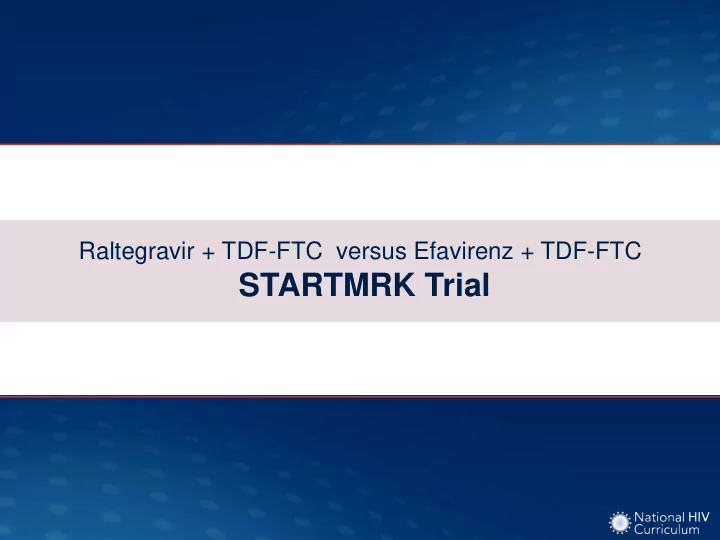

Raltegravir + TDF-FTC versus Efavirenz + TDF-FTC STARTMRK Trial
Raltegravir + TDF-FTC vs. Efavirenz + TDF-FTC STARTMRK: Study Design Study Design: STARTMRK Study • Background : Randomized, double-blind phase 3 study comparing the safety and efficacy of Raltegravir BID + raltegravir with efavirenz, in combination with co- TDF-FTC formulated tenofovir DF and emtricitabine for (n = 281) persons with HIV. • Inclusion Criteria (n = 569) - Antiretroviral-naïve patients - Age ≥18 years Efavirenz + TDF-FTC - HIV RNA ≥5000 copies/mL (n = 282) - No resistance to EFV, TDF, or FTC • Treatment Arms - Raltegravir + TDF-FTC - Efavirenz + TDF-FTC Source: Lennox JL, et al. Lancet. 2009;374:796-806.
Raltegravir + TDF-FTC vs. Efavirenz + TDF- FTC STARTMRK: Result Week 48: Virologic Response (Primary Analysis, M=F) Raltegravir + TDF-FTC Efavirenz + TDF-FTC 100 86 82 HIV RNA <50 copies/mL (%) 80 60 40 20 241/281 230/282 0 Source: Lennox JL, et al. Lancet. 2009;374:796-806.
Raltegravir + TDF-FTC versus Efavirenz + TDF-FTC STARTMRK: Result Week 48 Virologic Response (Observed-Failure Method) Raltegravir + TDF-FTC Efavirenz + TDF-FTC 100 HIV RNA <50 copies/mL (%) 93 92 91 89 89 89 80 60 40 20 241/263 230/258 111/120 114/128 130/143 116/130 0 ≤100,000 copies/mL Overall >100,000 copies/mL Baseline HIV RNA Level Source: Lennox JL, et al. Lancet. 2009;374:796-806.
Raltegravir versus Efavirenz in Combination Therapy STARTMRK Trial: Results Week 48 Virologic Response 100 HIV RNA <50 copies/mL (%) 80 60 Raltegravir + TDF-FTC Efavirenz + TDF-FTC 40 20 0 0 2 4 8 12 16 24 32 40 48 Time (weeks) Source: Lennox JL, et al. Lancet. 2009;374:796-806.
Raltegravir + TDF-FTC vs. Efavirenz + TDF-FTC STARTMRK: Result Adverse Events through 48 Weeks Raltegravir + TDF-FTC Efavirenz + TDF-FTC 100 77 80 Patients (%) 60 44 40 20 0 Drug-Related Adverse Event Source: Lennox JL, et al. Lancet. 2009;374(9692):796-806.
Raltegravir + TDF-FTC vs. Efavirenz + TDF-FTC STARTMRK: Result Week 48: Changes in Lipid Concentrations Raltegravir + TDF-FTC Efavirenz + TDF-FTC Mean Change from Baseline (mmol/L) 4 2.08 1.82 2 0.89 0.55 0.56 0.33 0.23 0 -0.16 -2 Total Cholesterol Triglycerides HDL LDL Source: Lennox JL, et al. Lancet. 2009;374(9692):796-806.
Raltegravir + TDF-FTC versus Efavirenz + TDF-FTC STARTMRK: Common Adverse Events Treatment Emergent Adverse Events in >10% of Subjects in Either Arm RAL + TDF-FTC EFV + TDF-FTC (n = 281) (n = 282) Dizziness 6% 34% Headache 9% 14% Abnormal dreams 7% 13% Immune Reconstitution Inflammatory 6% 4% Syndrome (IRIS) Source: Lennox JL, et al. Lancet. 2009;374:796-806.
Raltegravir + TDF-FTC versus Efavirenz + TDF-FTC STARTMRK: Conclusions Interpretation : “Raltegravir -based combination treatment had rapid and potent antiretroviral activity, which was non-inferior to that of efavirenz at week 48. Raltegravir is a well tolerated alternative to efavirenz as part of a combination regimen against HIV-1 in treatment-naive patients. ” Source: Lennox JL, et al. Lancet. 2009;374:796-806.
Raltegravir + TDF-FTC versus Efavirenz + TDF-FTC STARTMRK Trial: 156 Week Data
Raltegravir versus Efavirenz in Combination Therapy STARTMRK: Results at Week 156 Week 156: Virologic Response (Observed Failure Method) Efavirenz + TDF-FTC Raltegravir + TDF-FTC 100 HIV RNA < 50 copies/mL (%) 94 89 80 86 85 85 84 60 40 20 192/227 212/237 93/111 99/105 99/116 113/132 0 ≤ 100,000 copies/mL Overall > 100,000 copies/mL Baseline HIV RNA level Source: Rockstroh JK, et al. Clin Infect Dis. 2011;53:807-16.
Raltegravir versus Efavirenz in Combination Therapy STARTMRK Trial: Results at Week 156 Conclusions : “When combined with tenofovir/ emtricitabine in treatment- naive patients, raltegravir produced durable viral suppression and immune restoration that was at least equivalent to efavirenz through 156 weeks of therapy. Both regimens were well tolerated, but raltegravir was associated with fewer drug-related clinical adverse events and smaller elevations in lipid levels.” Source: Rockstroh JK, et al. Clin Infect Dis. 2011;53:807-16.
Raltegravir + TDF-FTC versus Efavirenz + TDF-FTC STARTMRK Trial: 240 Week Data
Raltegravir versus Efavirenz in Combination Therapy STARTMRK: Results at Week 240 Week 240: Virologic Response (Observed Failure Method) Efavirenz + TDF-FTC Raltegravir + TDF-FTC 100 HIV RNA < 50 copies/mL (%) 94 89 80 85 83 81 78 60 40 20 171/279 198/279 80/102 92/98 91/110 106/124 0 ≤100,000 copies/mL Overall >100,000 copies/mL Baseline HIV RNA level Source: Rockstroh JK, et al. J Acquir Immune Defic Syndr. 2013;63:77-85.
Raltegravir versus Efavirenz in Combination Therapy STARTMRK: Results at Week 240 Conclusions : “In this exploratory analysis of combination therapy with tenofovir/emtricitabine in treatment-naïve patients at week 240, vRNA suppression rates and increases in baseline CD4 counts were significantly higher in raltegravir than efavirenz recipients. Over the entire study, fewer patients experienced neuropsychiatric and drug-related adverse events in the raltegravir group than in the efavirenz group. Based on better virologic and immunologic outcomes after 240 weeks, raltegravir/tenofovir/emtricitabine seemed to have superior efficacy compared with efavirenz/tenofovir/emtricitabine. ” Source: Rockstroh JK, et al. J Acquir Immune Defic Syndr. 2013;63:77-85.
Acknowledgment The National HIV Curriculum is an AIDS Education and Training Center (AETC) Program supported by the Health Resources and Services Administration (HRSA) of the U.S. Department of Health and Human Services (HHS) as part of an award totaling $800,000 with 0% financed with non-governmental sources. This project is led by the University of Washington’s Infectious Diseases Education and Assessment (IDEA) Program. The content in this presentation are those of the author(s) and do not necessarily represent the official views of, nor an endorsement, by HRSA, HHS, or the U.S. Government.
Recommend
More recommend